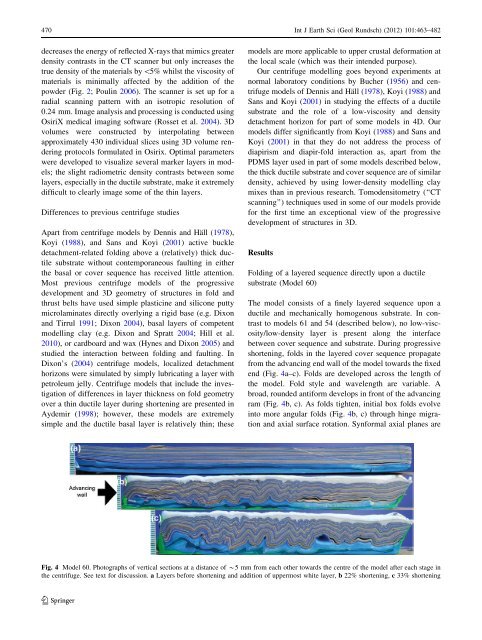Centrifuge modelling of deformation of a multi-layered sequence ...
Centrifuge modelling of deformation of a multi-layered sequence ...
Centrifuge modelling of deformation of a multi-layered sequence ...
You also want an ePaper? Increase the reach of your titles
YUMPU automatically turns print PDFs into web optimized ePapers that Google loves.
470 Int J Earth Sci (Geol Rundsch) (2012) 101:463–482decreases the energy <strong>of</strong> reflected X-rays that mimics greaterdensity contrasts in the CT scanner but only increases thetrue density <strong>of</strong> the materials by\5% whilst the viscosity <strong>of</strong>materials is minimally affected by the addition <strong>of</strong> thepowder (Fig. 2; Poulin 2006). The scanner is set up for aradial scanning pattern with an isotropic resolution <strong>of</strong>0.24 mm. Image analysis and processing is conducted usingOsiriX medical imaging s<strong>of</strong>tware (Rosset et al. 2004). 3Dvolumes were constructed by interpolating betweenapproximately 430 individual slices using 3D volume renderingprotocols formulated in Osirix. Optimal parameterswere developed to visualize several marker layers in models;the slight radiometric density contrasts between somelayers, especially in the ductile substrate, make it extremelydifficult to clearly image some <strong>of</strong> the thin layers.Differences to previous centrifuge studiesApart from centrifuge models by Dennis and Häll (1978),Koyi (1988), and Sans and Koyi (2001) active buckledetachment-related folding above a (relatively) thick ductilesubstrate without contemporaneous faulting in eitherthe basal or cover <strong>sequence</strong> has received little attention.Most previous centrifuge models <strong>of</strong> the progressivedevelopment and 3D geometry <strong>of</strong> structures in fold andthrust belts have used simple plasticine and silicone puttymicrolaminates directly overlying a rigid base (e.g. Dixonand Tirrul 1991; Dixon 2004), basal layers <strong>of</strong> competent<strong>modelling</strong> clay (e.g. Dixon and Spratt 2004; Hill et al.2010), or cardboard and wax (Hynes and Dixon 2005) andstudied the interaction between folding and faulting. InDixon’s (2004) centrifuge models, localized detachmenthorizons were simulated by simply lubricating a layer withpetroleum jelly. <strong>Centrifuge</strong> models that include the investigation<strong>of</strong> differences in layer thickness on fold geometryover a thin ductile layer during shortening are presented inAydemir (1998); however, these models are extremelysimple and the ductile basal layer is relatively thin; thesemodels are more applicable to upper crustal <strong>deformation</strong> atthe local scale (which was their intended purpose).Our centrifuge <strong>modelling</strong> goes beyond experiments atnormal laboratory conditions by Bucher (1956) and centrifugemodels <strong>of</strong> Dennis and Häll (1978), Koyi (1988) andSans and Koyi (2001) in studying the effects <strong>of</strong> a ductilesubstrate and the role <strong>of</strong> a low-viscosity and densitydetachment horizon for part <strong>of</strong> some models in 4D. Ourmodels differ significantly from Koyi (1988) and Sans andKoyi (2001) in that they do not address the process <strong>of</strong>diapirism and diapir-fold interaction as, apart from thePDMS layer used in part <strong>of</strong> some models described below,the thick ductile substrate and cover <strong>sequence</strong> are <strong>of</strong> similardensity, achieved by using lower-density <strong>modelling</strong> claymixes than in previous research. Tomodensitometry (‘‘CTscanning’’) techniques used in some <strong>of</strong> our models providefor the first time an exceptional view <strong>of</strong> the progressivedevelopment <strong>of</strong> structures in 3D.ResultsFolding <strong>of</strong> a <strong>layered</strong> <strong>sequence</strong> directly upon a ductilesubstrate (Model 60)The model consists <strong>of</strong> a finely <strong>layered</strong> <strong>sequence</strong> upon aductile and mechanically homogenous substrate. In contrastto models 61 and 54 (described below), no low-viscosity/low-densitylayer is present along the interfacebetween cover <strong>sequence</strong> and substrate. During progressiveshortening, folds in the <strong>layered</strong> cover <strong>sequence</strong> propagatefrom the advancing end wall <strong>of</strong> the model towards the fixedend (Fig. 4a–c). Folds are developed across the length <strong>of</strong>the model. Fold style and wavelength are variable. Abroad, rounded antiform develops in front <strong>of</strong> the advancingram (Fig. 4b, c). As folds tighten, initial box folds evolveinto more angular folds (Fig. 4b, c) through hinge migrationand axial surface rotation. Synformal axial planes areFig. 4 Model 60. Photographs <strong>of</strong> vertical sections at a distance <strong>of</strong> *5 mm from each other towards the centre <strong>of</strong> the model after each stage inthe centrifuge. See text for discussion. a Layers before shortening and addition <strong>of</strong> uppermost white layer, b 22% shortening, c 33% shortening123
















